RBSE Solutions for Class 11 Biology Chapter 5 Morphology of Flowering Plants
Rajasthan Board RBSE Solutions for Class 11 Biology Chapter 5 Morphology of Flowering Plants Textbook Exercise Questions and Answers.
Rajasthan Board RBSE Solutions for Class 11 Biology in Hindi Medium & English Medium are part of RBSE Solutions for Class 11. Students can also read RBSE Class 11 Biology Important Questions for exam preparation. Students can also go through RBSE Class 11 Biology Notes to understand and remember the concepts easily.
RBSE Class 11 Biology Solutions Chapter 5 Morphology of Flowering Plants
RBSE Class 11 Biology Morphology of Flowering Plants Textbook Questions and Answers
Question 1.
What is meant by modification of root? What type of modification of root is found in the:
(a) Banyan tree
(b) Turnip
(c) Mangrove trees.
Answer:
Modification of root is change in the shape, size and normal functioning of root to perform some secondary functions.
(a) Banyan tree: Prop roots
(b) Turnip: Napiform fleshy tap roots
(c) Mangrove trees: Pneumatophores (respiratory roots).

Question 2.
Justify the following statements on the basis of external features:
(i) Underground parts of a plant are not always roots.
(ii) Flower is a modified shoot.
Answer:
(i) In a few plants like ginger, stems remain underground for vegetative reproduction and storage of food. Similarly, stems in potato remain underground which are modified stems. Potato tuber indicates the presence of nodes (buds and scae eaves here) arid internodes. Presence of an apical bud at the tip of potato tuber affirms it to be a stem. Hence, the examples show that underground parts are not always roots.
(ii) Apical meristems give rise to floral meristems, and the axis of stem gets condensed while intemodes lie nearer to each other. Because of this flora appendages rise in place of stems, this justifies that flower is a modified shoot.
Question 3.
How is a pinnately compound leaf different from a palmately compound leaf?
Answer:
The differences are as follows:
|
Pinnately compond Leaf |
Palmately compound leaf |
|
1. Leaflets are borne in a pairs on an elongated axis (rachis) giving an appearance of feather. |
1. Leaflets are attached at the tip of petiols giving an appearance of hand. |
|
2. Leaflets occur in two ateral rows. |
2. Leaflets are clustered at one place. |
|
3. Leaflet bearing axis is the continuation of petiols or modified mid rib. It is prominent. |
3. The leaflet bearing axi is very short and represents the tip of petiole. It is not prominent. |
Question 4.
Explain with suitable examples the different types of phyllotaxy.
Answer:
Phyllotaxy is the pattern of arrangement of leaves on the stem or branch. This is usually of three types: alternate, opposite and whorled. In alternate type of phyllotaxy, a single leaf arises at each node in alternate manner, as in china rose, mustard and sunflower plants. In opposite type, a pair of leaves arise at each node and lie opposite to each other as in Calotropis and guava plants. If more than two leaves arise at a node and form a whorl, it is called whorled as in Alstonia.
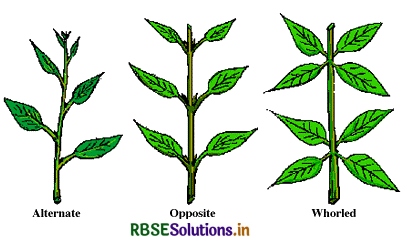
Question 5.
Define the following terms:
(a) Aestivation
(b) Placentation
(c) Actinomorphic
(d) Zygomorphic
(e) Superior ovary
(f) Perigynous flower
(g) Epipetalous stamen.
Answer:
(a) Aestivation: The mode of arrangement of sepals or petals in relation to one another in a flower bud is called aestivation.
(b) Placentation: The manner in which the ovules are attached in an ovary is called placentation.
(c) Actinomorphic: A flower with radial symmetry i.e., the parts of each whorl are similar in size and shape. The flower can be divided into two equal halves along more than one median longitudinal plane.
(d) Zygomorphic: A flower with bilateral symmetry i.e., the parts of one or mere whorls are dissimilar. The flower can be divided into two equal halves only in one vertical plane.
(e) Superior ovary: The ovary is called superior when it is borne above the point of attachments of perianth and stamens on thalamus.
(f) Perigynous flower: If gynoecium of a flower is situated in the centre and other parts such as perianth and stamens are located on the rim of thalamus the flower is called perigynous flower. If all the floral parts are at the same level.
(g) Epipetalous stamen: Stamens adhere to the petals by their fliaments and hence appearing to arise from them.

Question 6.
Differentiate between:
(a) Racemose and cymose inflorescence.
(b) Fibrous root and adventitious root.
(c) Apocarpous and syncarpous ovary.
Answer:
(a)
|
Racemose Inflorescence |
Cymose Inflorescence |
|
1. Growth of main axis is indefinite. |
1. Growth of main axis is definite due to formation of flower on the apical part. |
|
2. Older flower are present at the basal side of the main axis whereas new buds are formed at the apical side. |
2. Older flower are present at the apical side of the main axis whereas new buds are formed at the basal side. |
|
3. Arrangement of flowers is in acropetal manner. |
3. Arrangement of flowers is in basipetal manner. |
|
4. Number of flowers is indefinite. |
4. Number of flowers is definite. |
(b) Differences between fibrous and adventitious roots are as follows:
|
Fibrous Root |
Adventitlious Root |
|
Thread like branches of tap root, arising mainly from the various regions of the radicle, which behave in the same manner as the primary roots are called fibrous roots. |
The roots developing from anywhere except the radicle are called adventitious roots. |
(c) Apocarpous ovary means two or more carpels which are free. The syncarpous ovary means two or more carpels which are fused.
Question 7.
Draw the labelled diagram of the following:
(i) Gram seed
(ii) V.S. of maize seed.
Answer:
(i)
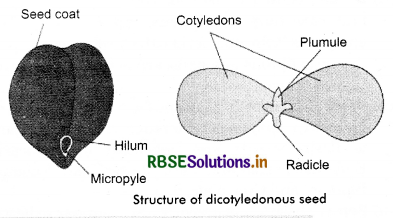
(ii)
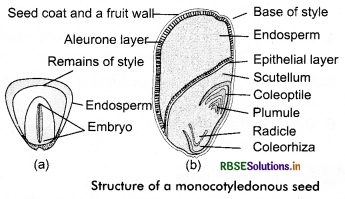
Question 8.
Describe modifications of stem with suitable examples.
Answer:
The stem may not always be typically like what they are expected to be. They are modified to perform different functions. Underground stems of potato, ginger, turmeric, Zaminkand, Colocasia are modified to store food in them. They also act as organs of perennation to tide over conditions unfavourable for growth. Stem tendrils which develop from axillary buds, are slender and spirally coiled and help plants to climb such as in gourds (cucumber, pumpkins, watermelon) and grapevines. Axillary buds of stems may also get modified into woody, straight and pointed thorns. Thorns are found in many plants such as Citrus, Bougainvillea. They protect plants from browsing animals. Some plants of arid regions modify their stems into flattened (Opuntia), or fleshy cylindrical (Euphorbia) structures. They contain chlorophyll and carry out photosynthesis.
Underground stems of some plants such as grass and strawberry, etc., spread to new niches and when older plants die new plants were formed. In plants like mint and jaismine a slender lateral branch arises from the base of the main axis and after growing aerially for some time arch down to touch the ground. A lateral branch with short internodes and each nodes bearing a rosette of leaves and a tuft of roots is found in aquatic plants like Pistia and Eichhornia. In banana, pineapple and Chrysanthemum, the lateral branches originate from the basal and underground portion of the main stem, grow horizontally beneath the soil and then come out obliquely upward giving rise to leafy shoots.
Question 9.
Take one flower each of the families fabaceae and solanaceae and write its semi - technical description. Also draw their floral diagram after studying them.
Answer:
Family Fabaceae:
This family was earlier called Papilionoideae, a subfamily of family Leguminoceae. It is distributed all over the world (5.35).
Vegetative Characters:
Habit: Trees, shrubs, herbs; root with root nodules.
Stem : erect or climber
Leaves: alternate, pinnately compound or simple; leaf base, pulvinate; stipulate; venation reticulate.
Floral Characters:
Inflorescence: racemose
Flower: bisexual, zygomorphic
Calyx: sepals five, gamosepalous: valvate /imbricate aestivation
Corolla: petals five, polvpetalous, papilionaceous, consisting of posterior standard, two lateral wings, two anterior ones forming a keel (enclosing stamens and pistil), vexillary aestivation.
Androecium: stamens ten, diadelphous, anther dithecous
Gynoecium: ovary superior, mono carpellary, unilocular and with many ovules, style single.
Fruit: legume; seed - one to many; non - endospermic.
Floral Formula: 
Economic Importance
1. Food:
- gram, pigeon pea, bean, soyabean etc are eaten as pulses. They are good source of protein.
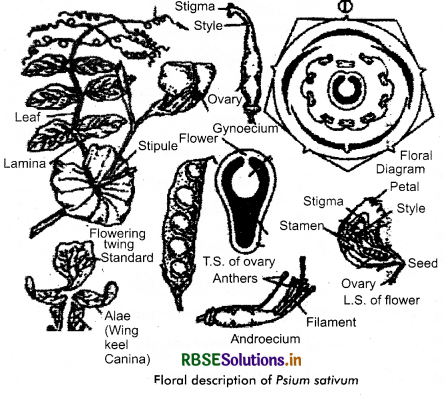
- soyabean, groundnut etc produces edible oil.
2. Fodder: Sesbania, Trifolium etc are used as fodder for cattle.
3. Timber wood: timber woods are obtained from sheesam (Dalbergia sisso)
4. Industry: Indigo dye (neel) obtained for Indigofera and fibers from Sunhemp.
5. Medicine: Liquorice (mulethi) obtained from root of Glycyrrhiza.
6. Ornamental plants: sweet pea, lupin are ornamental plants.
Family Solanaceae:
It is a large family, commonly called as the ‘potato family’. It is widely distributed in tropics, subtropics and even temperate zones.
Vegetative Characters:
Habit: Plants mostly herbs, shrubs and rarely small trees
Stem: herbaceous, rarely woody, aerial; erect, cylindrical, branched, solid or hollow, hairy or glabrous, underground stem in potato (Solarium tuberosum)
Leaves: alternate, simple, rarely pinnately compound, exstipulate; venation reticulate
Floral Characters:
Inflorescence: solitary, axillary or cymose as in Solarium.
Flower: bisexual, actinomorphic
Calyx: sepals five, united, persistent, valvate aestivation
Corolla: petals five, united; valvate aestivation.
Androecium: stamens five, epipetalous
Gynoecium: bicarpellary obligately placed, syncarpous; ovary superior, bilocular, placenta swollen with many ovules, axile.
Fruit: berry or capsule.
Seeds: many, endospermous
Floral Formula : 
Economic Importance
1. Food: tomato, brinjal, potato, etc are eaten as vegetables and salad, raspberry eaten as fruit and chilli used as spices.
2. Industry: leaves of tobacco are used in tobacco industry for making bidi, ciggrette etc.
3. Medicine: Different types of medicines are obtained from Atropa belladonna, Bignonia, Nicotiana etc.
Question 10.
Describe the various types of placentations found in flowering plants.
Answer:
Placentation: The arrangement of ovules within the ovary is known as placentation. The placentation are of different types namely, marginal, axile, parietal basal, central and free central.
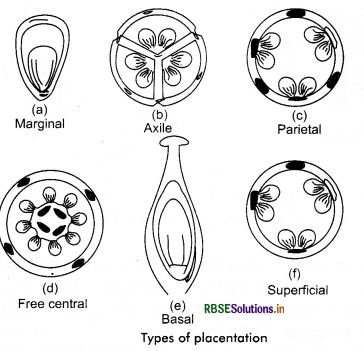
- Marginal placentation: In marginal placentation, the ovary is monocarpellary, unilocular and the placenta develops from the joining of both the margins of carpels, as in members of pea family.
- Axile placentation: In axile placentation, the ovary is multilocular and the number of carpels is more than one. Numbers of locules in ovary is almost equal to the number of carpels. Ovules join at the central axis of the ovary. Example: Datura, Hibiscus.
- Parietal placentation: In parietal placentation, the ovary is multicarpellary and unilocular. The ovules develop on the inner wall of the ovary or on peripheral part. Example : mustard, radish, papaya etc.
- Free central placentation: When the septa are absent in multilocular ovary, the ovules borne on the central axis then it is called free central placentation. Example: Stellaria, Primrose etc.
- Basal placentation: In this the ovary is unilocular and placenta develops directly on the thalamus. In this type of placentation, normally the number of ovule is one. Example: in plants of family Asteraceae like sunflower, marigold etc.
- Superficial placentation: Like axile placentation, in this also the ovary is multilocular but placenta develops on the entire inner surface of the septa. Example: water lily.
Question 11.
What is a flower? Describe the parts of a typical angiosperm flower.
Answer:
The flower is the reproductive unit in the angiosperms. It is meant for sexual reproduction. A typical flower has four different kinds of whorls arranged successively on the swollen end of the stalk or pedicel, called thalamus or receptacle. These are calyx, corolla, androecium and gynoecium. Calyx and corolla are accessory organs, while androecium and gynoecium are reproductive organs. In some flowers like lily, the calyx and corolla are not distinct and termed as perianth. When the flower has both androecium and gynoecium. it is bisexual. A flower having either only stamens or only carpels is unisexual.
In symmetry, the flower may be actinomorphic (radial symmetry) or zygomorphic (bilateral symmetry).When a flower can be divided into two equal radial halves in many radial planes passing through the centre, it is said to be actinomorphic, e.g., mustard, datura, chilli. When it can be divided into two similar halves only in one- particular vertical plane, it is zygomorphic, e.g., pea, gulmohur, bean, Cassia. A flower is asymmetric (irregular) if it cannot be divided into two similar halves by any vertical plane passing through the centre, as in canna. A flower may be trimerous, tetramerous or pentamerous when the floral appendages are in multiple of 3, 4 or 5, respectively. Flowers with bracts - reduced leaf found at the base of the pedicel - are called bracteate and those without bracts, ebracteate.
Based on the position of calyx, corolla and androecium in respect of the ovary on thalamus, the flowers are described as hypogynous, perigynous and epigynous (Fig. 5.16).
In the hypogynous flower the gynoecium occupies the highest position while other parts are situated below it. The ovary in such flowers is said to be superior, e.g., mustard, china rose, brinjal. If gynoecium is situated in the centre and other parts of the flower are located on the rim of the thalamus almost at the same level, it is perigynous. The ovary here is said to be half inferior, e.g.. plum, rose, peach. In epigynous flowers, the margin of thalamus grows upward enclosing the ovary completely and getting fused with it, the other parts of the flower arise above the ovary. Hence, the ovary is said to be inferior as in flowers of guava and cucumber, and the ray florets of sunflower.
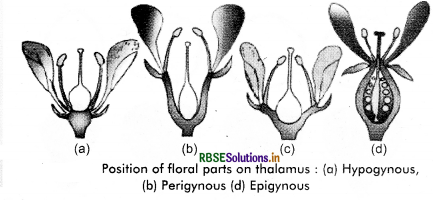
Question 12.
How do the various leaf modifications help plants?
Answer:
Leaves fundamentally perform photosynthesis. But in some plants leaves are modified to carry out different functions mentioned below:
Tendrils: Tendrils helps for climbing as in peas.
Pitcher: Leaves of this plant are modified into pitcher like structures containing digestive juice yielding in trapping and digesting insects.
Spines: Thorns are modified leaves which will protect plants from animals, serving as an organ of defence.
Synthesis of food: Fleshy leaves of garlic and onion store some food. These are modified leaves. Phyllodes emerging from petioles of leaves synthesize food. Phyllodes are flattned, green structures that replace the short lived leaves.

Question 13.
Define the term inflorescence. Explain the basis for the different types of inflorescence in flowering plants.
Answer:
A flower is modified shoot wherein the shoot apical meristem changes to floral meristem. Internodes do not elongate and the axis gets condensed. The apex produces different kinds of floral appendages laterally at successive nodes instead of leaves. When a shoot tip transforms into a flower, it is always solitary. The arrangement of flower on the floral axis is termed as Inflorescence. Depending on whether the apex gets developed into a flower or continues to grow, two major types of inflorescences are defined: racemose and cymose. In racemose type of inflorescence the main axis continues to grow, the flower are borne laterally in an acropetal manner. In cymose type of inflorescence the main axis terminates in a flower, hence is limited in growth. The flowers are borne in basipetal manner.
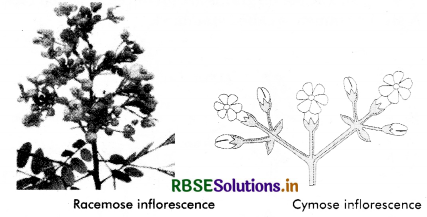
Question 14.
Write the floral formula of an actinomorphic, bisexual, hypogynous flower with five united sepals, five free petals, five free stamens and two united carples with superior ovary and axile placentation.
Answer:


- RBSE Solutions for Class 11 Biology Chapter 10 Cell Cycle and Cell Division
- RBSE Solutions for Class 11 Biology Chapter 9 Biomolecules
- RBSE Solutions for Class 11 Biology Chapter 8 Cell: The Unit of Life
- RBSE Solutions for Class 11 Biology Chapter 7 Structural Organisation in Animals
- RBSE Solutions for Class 11 Biology Chapter 6 Anatomy of Flowering Plants
- RBSE Solutions for Class 11 Biology Chapter 4 Animal Kingdom
- RBSE Solutions for Class 11 Biology Chapter 3 Plant Kingdom
- RBSE Solutions for Class 11 Biology Chapter 2 Biological Classification
- RBSE Solutions for Class 11 Biology Chapter 1 The Living World
- RBSE Solutions for Class 11 Biology Chapter 5 पुष्पी पादपों की आकारिकी
- RBSE Class 11 Biology Important Questions Chapter 1 The Living World